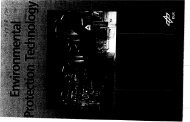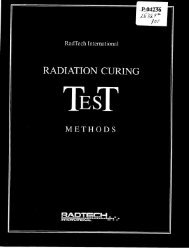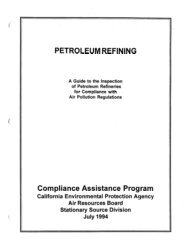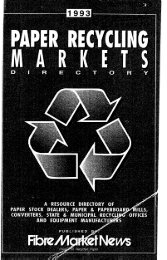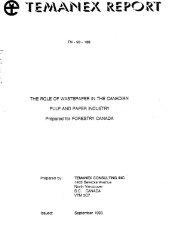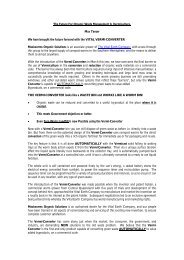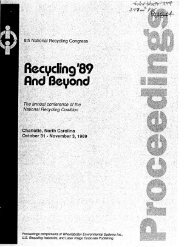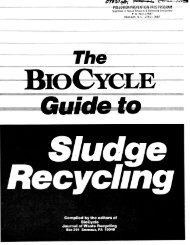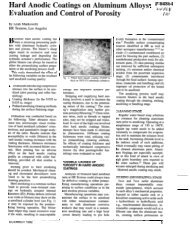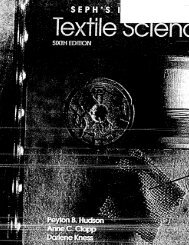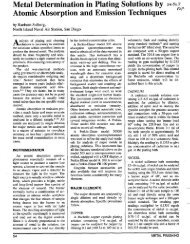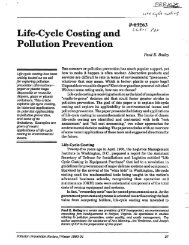Electronic Parts/Guidelines - infoHouse
Electronic Parts/Guidelines - infoHouse
Electronic Parts/Guidelines - infoHouse
You also want an ePaper? Increase the reach of your titles
YUMPU automatically turns print PDFs into web optimized ePapers that Google loves.
...<br />
Again, industry figures are unavailable, but one study on polystyrene manufacturing lists energy<br />
requirements at 120-180 kWh of electricity and approximately 5.000 kg of steam in producing one ton of<br />
product .<br />
Water Use: Water is used primarily for flushing and cooling purposes during the manufacture of<br />
styrene and polystyrene. Industry figures on this process were not available. However, one study<br />
cited 154 cubic meters of cooling water used per metric ton of material, a figure which does not include<br />
flushing and cleaning uses. Styrene production accounts for the discharge into "receiving waters" of<br />
1.7 Ibs. of water per 1,OOO Ibs of product. The industry reports that these discharges may include<br />
biological oxygen demand, chemical oxygen demand, suspended solids, dissolved solids, oil and<br />
grease, sulfides, and various metals including lead, mercury, iron, and aluminum.<br />
Air Emissions: There are large differences in air emissions between the manufacture of<br />
styrene/polystyrene resin and the polystyrene expansion process. While production of styrene resin<br />
emits .2 Ibs of emissions per 1,000 Ibs of product, foam sheet polystyrene production emits 25 Ibs of<br />
emissions per 1,ooO Ibs of product, and post-consumer polystyrene recycling is even higher at 27 Ibs of<br />
emissions per 1,ooO Ibs of product. The culprits are the blowing agents used in both virgin and recy-<br />
cled polystyrene foaming (expansion) processes. These blowing agents cannot be easily captured and<br />
recycled, and most are discharged to the air. While the industry has significantly reduced its contrib-<br />
utions to stratospheric ozone depletion by reducing and eliminating CFCs as blowing agents, substitute<br />
agents continue to generate environmental impacts. HCFCs, which have frequently replaced CFCs in<br />
the process, generate approximately 5% to 10% of the ozone depleting effect as their predecessors.<br />
Pentane, another popular CFC substitute, is not a stratospheric ozone depleter, but is a contributor to<br />
atmospheric ozone and thus to smog and global warming.<br />
Hazardous Waste: Hazardous waste generated from styrene/polystyrene production include cleaning<br />
and flushing solutions, solvents, lubrications, and inks. The 1991 industry "White Paper" on Styrene<br />
and Polystyrene Manufacture and Use did not release its figures for hazardous waste generation as it<br />
did for air and waterborne emissions and solid waste. However, that same paper indicated that indi-<br />
vidual plant facilities have in the past generated several hundred thousand tons of hazardous waste<br />
annually, pointing to a major impact industry-wide. Efforts in recycling and source reduction for these<br />
materials has generated significant decreases in many cases, but hazardous chemical waste gener-<br />
ation, transportation, and disposal remain a major environmental impact of the styrene/polystyrene<br />
manufacturing process.<br />
7.5.2.3 Packaging Material Usage<br />
Reusability: Most polystyrene used in electronics packaging is used once. Attempts to establish<br />
reuse systems for polystyrene caps and other electronics industry packaging are described in other<br />
sections of the Guide.<br />
Recyciabllity: Uncontaminated polystyrene is technologically recyclable into new plastic products. In<br />
response to recent demand for recycling systems, the polystyrene industry has set a goal to recycle<br />
25% of the polystyrene used in food service and packaging applications by 1995, and several regional<br />
recycling facilities have been opened. Recycling is becoming widely implemented and is expected to<br />
eventually reduce the use of virgin materials in the manufacture of polystyrene.<br />
Inclneratlon: Polystyrene is well suited for incineration, if this process represents the best choice for<br />
municipal solid waste handling. Polystyrene has an energy value of 18,400 Btu/pound, nearly as effi-<br />
cient as fossil fuels. Because most of the energy is released as heat, ash is minimal with very little<br />
toxicity. Refer to Table 11 on page 63 for energy content of other materials.<br />
CompostabilitylDegradabiiity: Polystyrene is unsuitable for composting purposes as it does not<br />
degrade organically and is inert in landfills.<br />
60 Environmental Packaaina <strong>Guidelines</strong>



